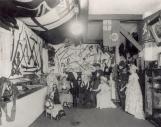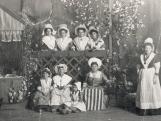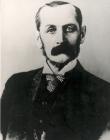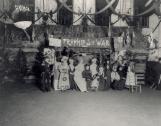1
The Women's Wentworth Historical Society: Determination in Preservation.3
The Women's Wentworth Historical Society was formed in 1899 with the goal of preserving the history of the site of the Battle of Stoney Creek and the house inhabited by the Gage family in the early 19th century. The following is an excerpt from a booklet published by the Women's Wentworth Historical Society in 1925."In the year 1899 the Ladies' Committee of the Wentworth Historical Society reorganized, changing its name to the Women's Wentworth Historical Society, of which Mrs. John Calder, a grand daughter (sic) of James Gage, was first President. Its first act was to purchase, by means of subscriptions from its citizens, four and a half acres of the land on which was fought the Battle of Stoney Creek, together with the Gage Homestead. After renovations to the house, and the grounds had been put in comparative order, this work being materially assisted by the residents of the surrounding country, it was on October 21st, 1899, by the Marchioness of Aberdeen, opened as a public park, the only instance of historic ground being owned and placed at the disposal of the general public by a private organization. When the society found in 1910 that an additional parcel of 13 acres of the original grant was for sale, no time was lost securing it. And now the park contains 17 1/2 acres in all, to which any one may have free access. The next step was to procure a monument to perpetuate the memory of those who fell at Stoney Creek and to mark the scene of action. After many years of importunity and knocking at the gates of Parliament a grant was made for the purpose, and the monument which stands on the hill south of the house was erected.
The various steps in connection with the monument are of interest. On the 28th of May, 1908, the first sod was turned by Lady Grey, wife of the Governor-General of that time. One year later on the 26th of May, Gen. Sir John French laid the corner stone. But the crowning day of all came on June 6th, 1913, the centenary of the battle, when Her Majesty, Queen Mary, by pressing a button in Buckingham Palace, unveiled the monument. In describing the event the London Graphic says: 'A special line connected Buckingham Palace with the office of the Commercial Cable Company, in Gracechurch Street, and the cable to which it was linked was kept clear for the ceremony. In the Queen's boudoir were placed a galvanometer and electric button, and pressure by the Queen's hand upon the latter completed the electric circuit and caused the wrappings about the memorial statue to fall away, while the galvanometer indicated that Her Majesty's signal had been effective.' A booklet containing photographs and accounts of the unveiling were forwarded to Her Majesty and the following letter of acknowledgement was received by the society: 'I beg to inform you that a dispatch has been received from the Secretary of State for the Colonies to the effect that your letter forwarding a record of the proceedings at the unveiling of the monument in memory of the Battle of Stoney Creek, was duly laid before Her Majesty, the Queen. Mr. Harcourt states that Her Majesty requested that her thanks might be returned to the Secretary for the sending of this book which it gave Her Majesty much pleasure to accept. I have the honour to be your obedient servant, (signed) C.J. Jones.'
Many floral memorial tributes were laid at the foot of the monument, conspicuous among them were two wreaths with copper shields, one of which had been sent from England by the members of the Veterans' Association of the Royal Berkshire Regiment, the other from the Regiment itself. Since then the society, by the generous assistance of the Ontario Legislature, has been enabled to realize another ambition, and the grounds have been laid out and developed, so that to-day (sic) there stands a beautiful park, dedicated to the use of the people, a fitting memorial to the valour of British arms.
On March 16th, 1914, the society suffered a great loss through the death of its President, Mrs. John Calder. To her belongs the credit for the foresight and the persistence in the face of difficulties, which has preserved for the people of Canada the scene of the stirring event of June 6th, 1813, whose results had so great a part in the maintenance of Upper Canada within the Empire. To her memory the society has placed in the house a portrait and tablet, but her greatest memorial lies all about.
The Women's Wentworth Historical Society carries on with the determination to keep its ideals and be a factor in the preservation and development of the patriotic spirit of the country."
5
The decision to build a monument in recognition of the Battle of Stoney Creek to the south of the Gage Homestead was not unanimously popular in the community. One such naysayer was George Mills, president of the Wentworth Historical Society, who believed that Sarah Calder was nothing more than an opportunist, who was interested in having a monument built close to her late grandparents house just to boost the Gage family name. Furthermore, he believed that the site chosen by Sara Calder was not the most relevant place to build a monument because most of the fighting during the Battle of Stoney Creek reportedly occured north of the Homestead, close to the road.7
In order to purchase the Gage Homestead and the surrounding property, the Women's Wentworth Historical Society held several fundraising event.9
In November 1895, the Women's Wentworth Historical Society held a week-long Military Encampment at the Hamilton Drill Hall that raised close to $1000. Admission to the event was 10 cents, or 25 cents including a meal. Considering the cost of admission, raising this amount of money was an amazing feat.In addition to the Military Encampment, the Women's Wentworth Historical Society was responsible for bringing many distinguished guests to the Battlefield House including: the Duke and Duchess of Connaught, Lord and Lady Aberdeen, the Duke and Duchess of Devonshire, the Earl and Countess of Bessborough, Lord and Lady Tweedsmuir, and Queen Elizabeth.
10
The Military Encampment, a week long fundraising event by the Women's Wentworth Historical Society.November, 1895

11
The Dutch Fete, one of the many fundraising events by the Women's Wentworth Historical Society.April, 1905

12
The Dutch Fete, held in April 1905, was another one of many successful fundraisers held by the Women's Wentworth Historical Society, helping to raise $470.13
Countess Grey, wife of the Governor General, turning the first sod for the Monument on May 28, 1909.28 May 1909
Battlefield Park, Stoney Creek, Ontario




